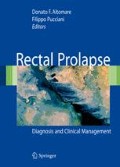Abstract
Rectal prolapse has a profound effect on quality of life and has been associated with a multitude of surgical treatment options since its original description. It is defined as a full-thickness protrusion of the rectal wall through the anal sphincter. Clinical management is confounded by the fact that whereas 75% of patients with rectal prolapse experience problems with anal incontinence, 25–50% will have significant constipation [1]–[4]. Symptoms of anal incontinence may be due to acquired changes in bowel motility or a reduction in resting anal pressure as a result of continual activation of rectoanal inhibition –7]. Constipation in patients with rectal prolapse may be a consequence of slow colonic transit or an increase in external anal sphincter contractions 4, 8. These symptoms have a significant influence on the choice of operative approach in the treatment of rectal prolapse. However, due to the variable results of operative approaches, it is unclear whether optimal treatment can be selected based on preoperative physiologic testing.
Access this chapter
Tax calculation will be finalised at checkout
Purchases are for personal use only
Preview
Unable to display preview. Download preview PDF.
References
Madden MV, Kamm MA, Nicholls RJ et al (1992) Abdominal rectopexy for complete rectal prolapse: prospective study evaluating changes in symptoms and anorectal function. Dis Colon Rectum 35:48–55
Keighley MRB, Fielding JWL, Alexander-Williams J (1983) Results of Marlex mesh abdominal rectopexy for rectal prolapse in 100 consecutive patients. Br J Surg 70:229–232
Madoff RD, Williams JG, Wong WD et al (1992) Longterm functional results of colon resection and rectopexy for overt rectal prolapse. Am J Gastroenterol 87:101–104
Metcalf AM, Loening-Baucke V (1988) Anorectal function and defecation dynamics in patients with rectal prolapse. Am J Surg 155:206–210
Keighley MRB, Shouler PJ (1984) Abnormalities of colonic function in patients with rectal prolapse and faecal incontinence. Br J Surg 71:892–895
Matheson DM, Keighley MRB (1981) Manometric evaluation of rectal prolapse and faecal incontinence. Gut 22:126–12
Gordon PH (1999) Rectal procidentia. In: Gordon PH, Nivatvongs S. Principles and practice of surgery for the colon, rectum, and anus. Quality Medical Publishers, St. Louis, pp. 503–540
Madoff RD (1992) Rectal prolapse and intussusception. In: Beck WE, Wexner SD, eds. Fundamentals of anorectal surgery. McGraw-Hill, New York, pp 89–103
Watts JD, Rothenberger DA, Buls JG et al (1985) The management of procidentia: thirty years’ experience. Dis Colon Rectum 28:96–102
Eu K-W, Seow-Choen F (1997) Functional problems in adult rectal prolapse and controversies in surgical treatment. Br J Surg 84:904–911
Douard R, Frileux P, Brunel M et al (2003) Functional results after the Orr-Loygue transabdominal rectopexy for complete rectal prolapse. Dis Colon Rectum 46:1089–1096
Watkins BP, Landercasper J, Belzer E et al (2003) Long-term follow-up of the modified Delorme procedure for rectal prolapse. Arch Surg 138:498–503
Bartolo CC (1996) Rectal prolapse. Br J Surg 83:3–5
Duthie GS, Bartolo DC (1992) Abdominal rectopexy for rectal prolapse: a comparison of techniques. Br J Surg 79:107–113
Huber FT, Stein H, Siewert JR (1995) Functional results after treatment of rectal prolapse with rectopexy and sigmoid resection. World J Surg 19:138–143
Kimmins MH, Evetts BK, Isler J, Billingham R (2001) The Altemeier repair: outpatient treatment of rectal prolapse. Dis Colon Rectum 44:565–570
Berman IR (1992) Sutureless laparoscopic rectopexy for procidentia: technique and implications. Dis Colon Rectum 35:689–693
Carpelan-Holmström M, Kruuna O, Scheinin T (2006) Laparoscopic rectal prolapse surgery combined with short hospital stay is safe in elderly and debilitated patients. Surg Endosc 20:1353–1359
Cirocco WC, Brown AC (1993) Anterior resection for the treatment of rectal prolapse: a 20-year experience. Am Surg 59:265–269
Giordano P, Wexner SD (2001) The assessment of fecal incontinence in women. J Am Coll Surg 193(4): 397–406
Baker R, Senagore AJ, Luchtefeld M (1995) Laparoscopic-assisted vs. open resection: rectopexy offers excellent results. Dis Colon Rectum 38:199–201
Boccasanta P (1999) Laparotomic vs. laparoscopic rectopexy in complete rectal prolapse. Dig Surg 16(5):415–419
Boccasanta P, Rosati R, Venturi M et al (1998) Comparison of laparoscopic rectopexy with open technique in the treatment of complete rectal prolapse: clinical and functional results. Surg Laparosc Endosc 8(6):460–465
Kessler H, Jerby BL, Milsom JW (1999) Successful treatment of rectal prolapse by laparoscopic suture rectopexy. Surg Endosc 13:858–861
Darzi A, Henry MM, Guillou PJ et al (1995) Stapled laparoscopic rectopexy for rectal prolapse. Surg Endosc 9:301–303
Rose J, Schneider C, Scheidbach H et al (2002) Laparoscopic treatment of rectal prolapse: experience gained in a prospective multicenter study. Langebecks Arch Surg 387(3–4):130–137
Solomon MJ, Young CJ, Eyers AA, Roberts RA (2002) Randomized clinical trial of laparoscopic versus open abdominal rectopexy for rectal prolapse. Br J Surg 89:35–39
Kairaluoma MV, Viljakka MT, Kellokumpu IH (2003) Open vs. laparoscopic surgery for rectal prolapse. Dis Colon Rectum 46:355–360
Himpens J, Cadiere GB, Bruyns J, Vertruyen M (1999) Laparoscopic rectopexy according to Wells. Surg Endosc 13:139–141
Xynos E, Chrysos E, Tsiaoussis J et al (1999) Resection rectopexy for rectal prolapse: the laparoscopic approach. Surg Endosc 13:862–864
Heah SM, Hartley JE, Hurley J et al (2000) Laparoscopic suture rectopexy without resection is effective treatment for full-thickness rectal prolapse. Dis Colon Rectum 43(5):638–643
Bruch HP, Herold A, Schiedeck T, Schwandner O (1999) Laparoscopic surgery for rectal prolapse and outlet obstruction. Dis Colon Rectum 42:1189–1195
D’Hoore A, Cadoni R, Penninckx F (2004) Long-term outcome of laparoscopic ventral rectopexy for total rectal prolapse. Br J Surg 91:1500–1505
Madbouly KM, Senagore AJ, Delaney CP et al (2003) Clinically based management of rectal prolapse. Surg Endosc 17(1):99–103
Zittel TT, Manncke K, Haug S et al (2000) Functional results after laparoscopic rectopexy for rectal prolapse. J Gastrointest Surg 4(6):632–641
Author information
Authors and Affiliations
Editor information
Editors and Affiliations
Rights and permissions
Copyright information
© 2008 Springer-Verlag Italia
About this chapter
Cite this chapter
Metcalf, D.R., Senagore, A.J. (2008). Management of Rectal Prolapse: The Role of Laparoscopic Approaches. In: Altomare, D.F., Pucciani, F. (eds) Rectal Prolapse. Springer, Milano. https://doi.org/10.1007/978-88-470-0684-3_20
Download citation
DOI: https://doi.org/10.1007/978-88-470-0684-3_20
Publisher Name: Springer, Milano
Print ISBN: 978-88-470-0683-6
Online ISBN: 978-88-470-0684-3
eBook Packages: MedicineMedicine (R0)

